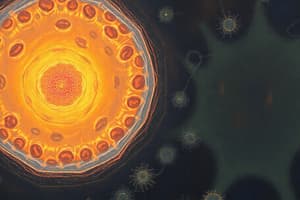Podcast
Questions and Answers
Which of the following cells do not contain a nucleus?
Which of the following cells do not contain a nucleus?
- Plant Cells
- Animal Cells
- Prokaryotic Cells (correct)
- Eukaryotic Cells
What are Eukaryotic Cells?
What are Eukaryotic Cells?
Eukaryotic cells are cells that contain a nucleus and organelles.
What is the function of ribosomes?
What is the function of ribosomes?
Ribosomes make proteins.
The _______ is a large membrane-enclosed structure that contains the cell's genetic material.
The _______ is a large membrane-enclosed structure that contains the cell's genetic material.
What is the function of the Golgi apparatus?
What is the function of the Golgi apparatus?
Chloroplasts are involved in photosynthesis.
Chloroplasts are involved in photosynthesis.
Which of the following structures is involved in cell movement?
Which of the following structures is involved in cell movement?
What is the role of mitochondria?
What is the role of mitochondria?
The _____ consists of membranes inside and around a eukaryotic cell.
The _____ consists of membranes inside and around a eukaryotic cell.
Passive transport requires energy to occur.
Passive transport requires energy to occur.
What is osmosis?
What is osmosis?
What kind of solution causes a cell to shrink due to water loss?
What kind of solution causes a cell to shrink due to water loss?
Define diffusion.
Define diffusion.
What is the primary function of the sodium-potassium pump?
What is the primary function of the sodium-potassium pump?
What structure surrounds the nucleus?
What structure surrounds the nucleus?
Plasmolysis occurs when a cell is in a hypotonic environment.
Plasmolysis occurs when a cell is in a hypotonic environment.
What is facilitated diffusion?
What is facilitated diffusion?
Flashcards are hidden until you start studying
Study Notes
Cell Types
- Prokaryotic Cells: Lack a nucleus, contain DNA in the nucleoid, and have minimal organelles. Responsible for basic life functions and movement. Bacteria are examples.
- Eukaryotic Cells: Contain a nucleus and chromosomes. Possess organelles and internal membranes. Include organisms like plants, animals, fungi, and protists.
Cell Components
- Cytosol/Cytoplasm: Region outside the nucleus involving various cellular activities.
- Organelle: Specialized structures within cells that perform distinct functions.
- Nucleus: Enclosed by a membrane, containing DNA, controls cellular activities.
- Chromosomes: Threadlike DNA structures carrying genetic information, inherited through generations.
- Chromatin: Granular DNA material in the nucleus that condenses into chromosomes.
Genetic Information
- Genes: DNA sequences coding for proteins that dictate traits.
- Nucleolus: Small structure within the nucleus, involved in ribosome production.
- Nuclear Envelope: Double membrane surrounding the nucleus, with nuclear pores for substance transport.
Ribosomes
- Ribosomes: RNA particles responsible for protein synthesis, following genetic instructions.
- Free Ribosomes: Scattered in the cytoplasm, producing proteins that enter the cytosol.
- Bound Ribosomes: Attached to the endoplasmic reticulum (ER), synthesize proteins for membrane incorporation or packaging.
Endomembrane System
- Endomembrane System: Network of membranes including the ER, Golgi apparatus, lysosomes, and vacuoles involved in protein and lipid transport and storage.
Endoplasmic Reticulum (ER)
- Rough ER: Has surface ribosomes involved in protein synthesis.
- Smooth ER: Lacks ribosomes; involved in lipid synthesis and detoxification processes.
Organelles Involved in Processing and Energy
- Golgi Apparatus: Modifies, sorts, and packages proteins from the ER for storage or export.
- Lysosomes: Enzyme-filled organelles responsible for breaking down cellular waste and macromolecules.
- Peroxisomes: Organelles involved in metabolic processes, found in most cells.
- Mitochondria: Convert food chemical energy into usable compounds. Known as the powerhouses of the cell.
- Plastids: Plant organelles for storage of substances like starches and pigments.
Storage Structures
- Chloroplasts: Organelles that capture sunlight energy for photosynthesis.
- Vacuoles: Sac-like structures for storage of materials such as water and nutrients.
Cytoskeleton
- Cytoskeleton: Protein filament network that maintains cell shape and aids in movement.
- Microfilaments: Thin fibers for support and movement.
- Microtubules: Hollow protein structures essential for cell shape and division.
- Centrioles: Organize cell division; absent in plant cells.
- Basal Bodies: Centrioles at the base of cilia and flagella.
Cell Movement Structures
- Flagella: Long, whip-like structures for cell movement, wiggle in prokaryotes and spin in eukaryotes.
- Cilia: Short, hairlike structures that move in waves to propel cells.
Membrane Structure and Function
- Plasma (Cell) Membrane: Phospholipid bilayer with embedded proteins that regulate entry and exit of substances.
- Fluid-Mosaic Model: Describes the arrangement of proteins in a flexible, fluid membrane structure.
Transport Mechanisms
- Diffusion: Movement of particles from areas of high to low concentration.
- Passive Transport: Gradient-based movement without energy input.
- Active Transport: Energy-consuming movement against concentration gradients.
- Osmosis: Water diffusion across semi-permeable membranes.
- Selectively Permeable Membrane: Allows specific substances to pass while blocking others.
Solutions and Concentration
- Hypertonic: Higher concentration of solutes outside the cell, causing water loss.
- Hypotonic: Lower concentration of solutes outside, leading to water influx.
- Isotonic: Equal solute concentration inside and outside the cell.
Cellular Processes
- Plasmolysis: Shrinking of the cell in a hypertonic environment due to water loss.
- Lysis: Destruction or dissolution of cells.
- Facilitated Diffusion: Movement assisted by transport proteins.
- Endocytosis: Cellular uptake of substances via membrane engulfing.
- Phagocytosis: Engulfing of large particles by cytoplasm extensions.
- Exocytosis: Release of substances via vesicle fusion with the membrane.
Studying That Suits You
Use AI to generate personalized quizzes and flashcards to suit your learning preferences.




